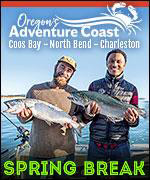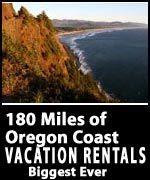Life Finds Home on Ropes Beneath Oregon Coast, Washington Coast
Published 07/31/22 at 4:45 AM PST
By Oregon Coast Beach Connection staff
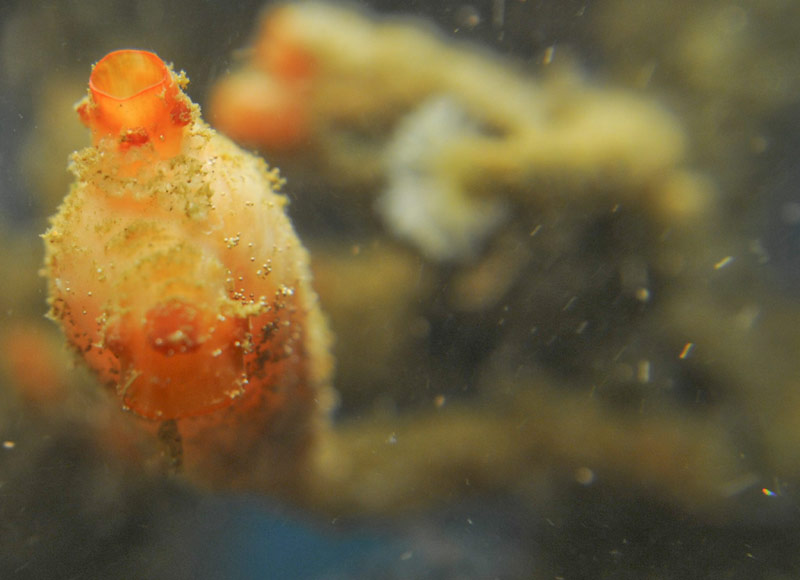
Includes exclusive listings; some specials in winter
In Cannon Beach:
Includes rentals not listed anywhere else
In Manzanita, Wheeler, Rockaway Beach:
Some specials for winter
In Pacific City, Oceanside:
Some specials for winter
In Lincoln City:
Some specials for winter
In Depoe Bay, Gleneden Beach:
Some specials for winter
In Newport:
Look for some specials
In Waldport
Some specials for winter
In Yachats, Florence
Some specials for winter
Southern Oregon Coast Hotels / Lodgings
Reedsport to Brookings, places to stay; winter deals
(Seaside, Oregon) - For such a beautiful place, the ocean is actually fairly weird. On the surface it's all calming waves and hypnotizing tidelines, but underneath life is doing some extraordinary stuff. Just beyond those lovely beaches of the Oregon coast or Washington coast, the real estate gets bizarre. (All photos courtesy Seaside Aquarium. Above: closeup of a stalked tunicate on a rope)
It all kind hearkens back to that line in Jurassic Park: “Life will find a way.”
Seaside Aquarium finds wacky examples of this quite a bit, like lifeforms living on and thriving off manmade debris that's normally bad for sea creatures. Rope is a prime example, according to the aquarium's Tiffany Boothe.
“Discarded ropes can cause serious, life-threatening entanglement issues for many marine animals,” Boothe said. “They can, however, also provide a place for many marine organisms to settle and live.”
Scouring the beaches of the Washington coast and Oregon coast all the time, crew from the aquarium have made some wild finds and then brought them into their tanks on occasion. Sometimes fishermen turn them in as well. Tiny but spectacularly beautiful creatures like tunicates, zoanthids, tubeworms and mussels sometimes show up as small colonies living on this stuff.
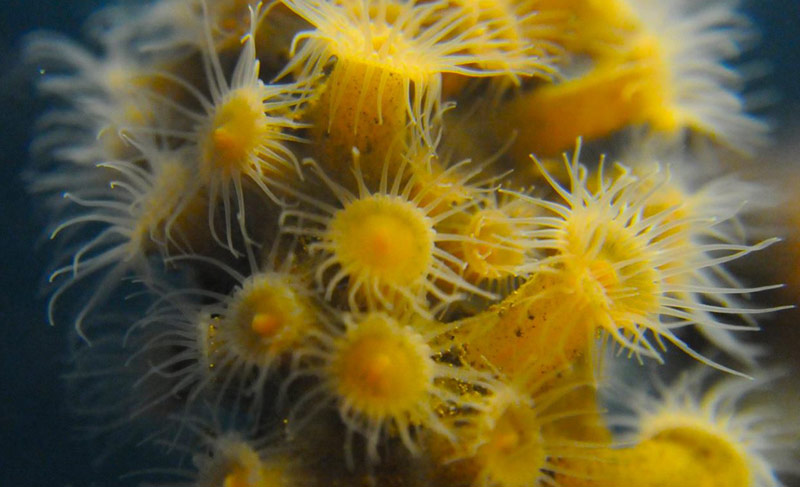
Zoanthids are kind of like anemones, and they live in groups and clusters on objects in the ocean. They can connect to each other and form colonies via a sheet of tissue at the bottom of each individual. The photo above shows Orange Zoanthids.
They're rather neurotic, you might say. Boothe said if they get disturbed or threatened somehow they will contract their tentacles and then it takes sometimes hours to calm the hell down and expand these appendages once more.
Various types of tunicates are another little critter found on rope debris lying beneath the Oregon or Washington coast. The photo at the very top is not only an elegant, beautiful study in marine life, but it manages to look a bit like interstellar formations captured in the galaxy by major telescopes.
Boothe explains what you're seeing.
“Among the three species of tunicates which settled on the lost rope was this stalked tunicate,” Boothe said. “Stalked tunicates are often seen in local tidepools, however they are usually mistaken for some sort of kelp or seaweed.”
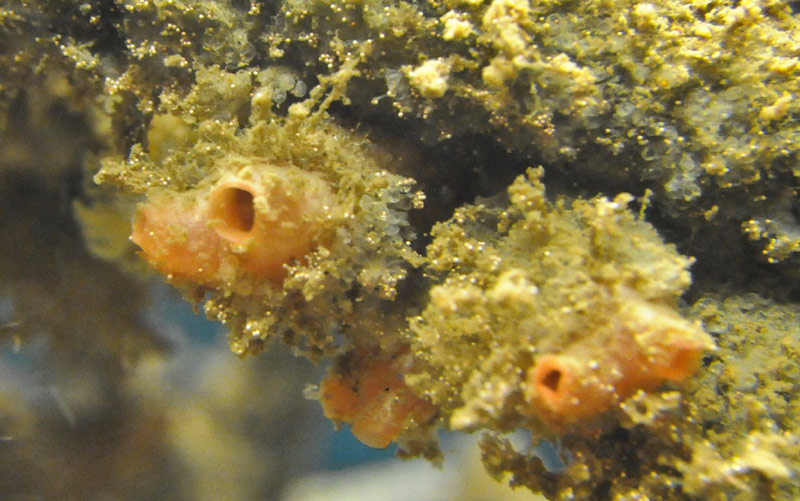
Above: three different types of tunicates on one rope
Tunicates belong to the same phylum as vertebrates, and they include things like salps – which are trippy little see-through creatures sometimes found on Oregon's coast or the Washington coastline. These tunicates are tinier. Adults don't have a backbone, but as larvae they begin life with a tail, a nerve chord and something called a notochord, which is a bit like a backbone. While not made of any kind of bone, it does stiffen their body and functions like a backbone.
Here's a weird fact: because of that brief part of their lives with a kind of backbone, they're considered closer relatives to humans than fish.
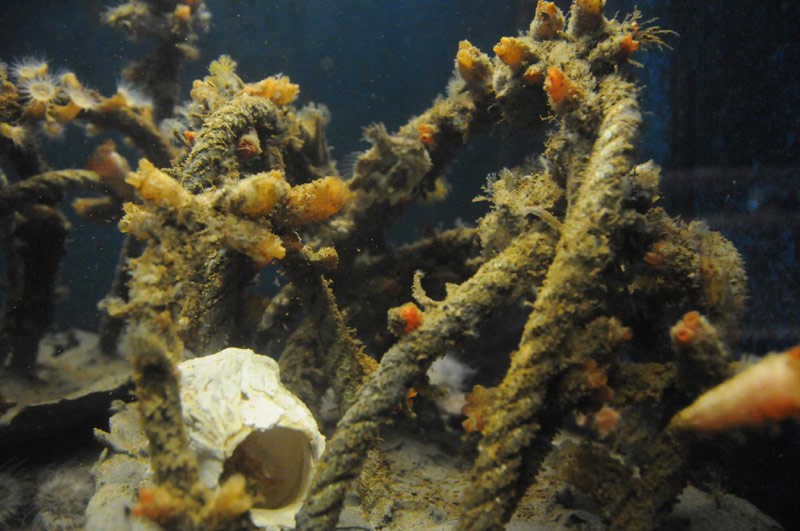
The rope photo here shows all kinds of creatures in residence: mussels, tubeworms, zoanthids and tunicates. This particular example washed up at Seaside in the early 2010's.
The California mussel begins life as a free-swimming form of plankton – that tiny, yummy treat that everything in the ocean survives on in some way, including whales. For the first few months of their lives, Boothe said, they float aimlessly along the ocean's currents and feed on phytoplankton (the form of plankton that is made of nearly microscopic plants).
As it ages, it rather abruptly forms a shell and then sinks to the ocean floor, where it starts traveling on a single foot. It's enough of an outlier in the animal kingdom that computer simulations trying to guess at what alien life on other planets might be like have included creatures a bit like this.
Eventually, the mussel attaches itself to some hard surface by a liquid adhesive traveling down this foot-like appendage, and the cold of sea water does the rest of the job hardening it. They've been known to live in the same spot for 20 years.
Tubeworms are generally marine worms found swimming inside of a tube, which is created by secreting a calcium substance that makes a hardened structure around their bodies. But some others, like the ones seen in the photos from the Seaside Aquarium, have a more flexible see-through structure that's akin to a human fingernail.
Oregon Coast Hotels for this event - South Coast Hotels - Where to eat - Maps - Virtual Tours
Cannon Beach Lodging
Nehalem Bay Lodgings
Manzanita Hotels, Lodging
Three Capes Lodging
Pacific City Hotels, Lodging
Lincoln City Lodging
Depoe Bay Lodging
Newport Lodging
Waldport Lodging
Yachats Lodging
Oregon Coast Vacation Rentals
Oregon Coast Lodging Specials
More About Oregon Coast hotels, lodging.....
More About Oregon Coast Restaurants, Dining.....
LATEST Related Oregon Coast Articles
Over 60 people now unemployed. Company owed 100s of thousands in taxes, rent. Salem, Monmouth, restaurant reviews
N. Oregon Coast Fave Given All-Clear: City of Cannon Beach Says Gower Access ...
Gower St. access / Haystack Rock had signs to keep out of water
Some Thanksgiving and Holiday Weekend Vacation Rentals Still Open on Oregon C...
A handful of vacation rentals and one restaurant's feast: Newport hotel reviews, Lincoln City hotel reviews, Pacific City hotel reviews, Neskowin hotel reviews, Washington coast, specials
Tsunami Alerts May Get Delayed, Not as Accurate for Oregon / Washington Coast
Funding cut off for some seismic stations, leaves coast more vulnerable. Weather
Oregon's Southern Curry Coast for the Holidays - and 2026 Preview
Holidays in Port Orford, Brookings, Gold Beach plus 2026 events. South coast events. Gold Beach Christmas, Dec.; Gold Beach Floats, Apr; Azalea Festival May; Brookings Art Walk, Brookings Art at the Port, Bootleg Festival, June; Solstice Shred, June; Bigfoot Blues, July; Pirates Fest, Aug.
First Day Hikes Take Place All Over Oregon and Coast to Start 2026
A special tradition in Yachats, but also Brookings events, Gold Beach events, Port Orford events, Coos Bay events, Bandon events, Florence events, Yachats events, Newport events, Lincoln City events, Rockaway Beach events, Manzanita events, Cannon Beach events, Seaside events, Astoria events
Variety of Oregon State Parks Closed Due to Storm, from Coast to Columbia Gorge
Silverton, Estacada, Coastline and others: several parks damaged or closed. Weather
Supermoon Coincides with Washington / Oregon Coast King Tides: What That Means
Biggest factors in all this are major wave systems but supermoon has influence. Astronomy, weather
Back to Oregon Coast
Contact Advertise on Oregon Coast Beach Connection
All Content, unless otherwise attributed, copyright Oregon Coast Beach Connection. Unauthorized use or publication is not permitted














